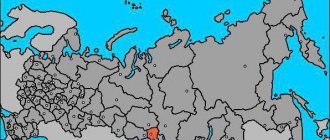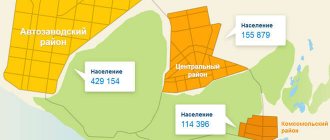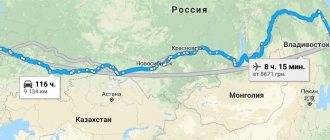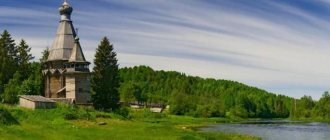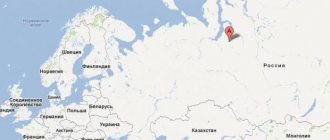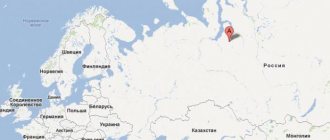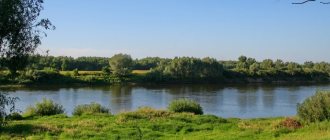Moore. A city with a thousand-year history
Murom, located on the left bank of the Oka , is one of the most ancient cities in the country, which is rightly called the same age as the thousand-year-old Russian statehood.
For centuries, it remained a strategically important outpost on the eastern borders of Rus', serving as a stage for bloody internecine military battles and brutal, ruinous raids. Murom survived terrible fires, Tatar invasions, the Time of Troubles, and each time it rose from the ruins and ashes.
Today this small city in the Vladimir region has just over 110 thousand inhabitants. Murom is located 137 km from the regional center of Vladimir. It is distinguished by its special charm, demonstrating to the admiring tourist the wealth of golden domes and the solidity of ancient buildings.
“Whoever has not seen the city from the Oka has not seen Russian beauty,” Maxim Gorky . This is a place of folk epics and legends, priceless architectural monuments of different times. The city is considered the birthplace of the famous epic hero Ilya Muromets, the defender of his native land, whose personality has long been his calling card.
The fates of twenty Orthodox saints who distinguished themselves by their mercy, piety, and fortitude are closely connected
with Murom It is not surprising that thousands of pilgrims strive to get to the praying monasteries and churches.
The first mention of Murom is found in the “Tale of Bygone Years” by Nestor the Chronicler and dates back to 862. This significant date is considered “the beginning of the Russian state.” According to one version, the city received its name from the ancient Finno-Ugric tribe that previously inhabited these regions.
In ancient Scandinavian literature the city is described under the name Muromar. The shipping route from the steppe to Europe passed through it, and the majestic city captivated passing foreigners with its beauty.
The Slavs came to these places at the beginning of the 9th century. The first ruler to come to Murom from Kiev was Gleb , the son of Prince Vladimir. He ruled for 17 years, from 988, and was killed, according to various versions, either by his brother Yaroslav the Wise or by the soldiers of Svyatopolk. Gleb and his brother Boris became the first Murom saints.
After the Baptism of Russia in Murom, for a century, residents still continued to worship pagan deities. According to legend, an icon that began to glow helped convert the townspeople to Christianity. Constantine carried out a mass baptism of the inhabitants, the prince and his sons were later canonized. The relics of the saints today are in the beautiful Annunciation Monastery.
Murom more than once became the center of military battles with the Polovtsy and Volga Bulgars. The city was burned by the Tatars in 1239. The Time of Troubles lasted until the middle of the 16th century. Ivan the Terrible’s successful military campaign against Kazan , the borders were pushed east, and a period of restoration and prosperity began in Murom.
In the 17th-19th centuries, the city acquired great commercial importance, as it was located at the crossroads of trade routes. Crafts actively developed in Murom, especially weapons and leatherworking. There was a whole settlement of tanners in the city; special wells were built for soaking raw materials. Local residents successfully made soap and wove canvas.
Agriculture also flourished. A funny historical fact is the story about bribes with seeds (including the famous cucumbers) that were given to officials. Empress Catherine II herself liked the baked goods and confectionery products of local craftsmen. The most delicious Murom sterlet on a stick was delivered directly to Her Majesty’s court.
The heyday of merchant Murom came in the 60s of the 19th century, largely thanks to Alexei Vasilyevich Ermakov. He came from Chelyabinsk, became rich and became a merchant of the first guild. He was elected to the post of mayor three times, and during his six years of work he managed to leave a memory of himself for centuries.
The Ermakov family was rich, but childless. The mayor directed not only energy, but also personal capital to the improvement of the city. Under him, a theater was built, a telegraph was installed, and a water supply system was laid. The Ermakovs opened a hospital, a shelter for children and a library in Murom. The water tower (1864), built at the expense of the mayor, has survived to this day.
the St. Nicholas-Mozhaisk Church , the Church of the Nativity were wiped off the face of the earth .
Source: online magazine Travel and the World Around Us
Order now!
Your ad could be here!
https://nashural.ru Your advertisement will be seen by thousands of people a day
Interesting? Tell your friends!
MOORE
MURO, a city in Russia, in the southeast. parts of the Vladimir region, the center of the city district of the same name and the Murom municipal district. Us. 107.0 thousand people (2019; 3rd city in the region by number of inhabitants after Vladimir and Kovrov). Located on the left bank of the river. Oka (port), on the border with the Nizhny Novgorod region. A junction of railways and roads (M. is connected to the right bank by railways and cable-stayed road bridges).
Story
First mentioned in The Tale of Bygone Years under 862. Old Russian. the city of M. was founded on the Kremlin Mountain in the 2nd half. 10th century immigrants from the Rostov-Suzdal principality. Within the historical The cultural layer of the city is located Karacharovskaya Upper Paleolithic. parking lot (on the territory of the former village of Karacharovo), an early Iron Age settlement, 2 Murom ground burial grounds (7th–11th, 10th–11th centuries), 3 ancient Russian. settlements (12th–13th centuries). A treasure of 11,077 Kufic dirhams and their scraps (715–939) was found in the Kremlin; The remains of a Muroma sanctuary were also discovered here. Among the finds there are also imported items - jewelry made of stone, glass, and ceramics. Byzantine, Bulgarian and Middle Asian products. origin.
OK. 988 M. transferred to the Kyiv prince. Vladimir Svyatoslavich into the possession of the prince. Gleb Vladimirovich (see in the article Boris and Gleb). In the end 10 – start 11th centuries built wooden c. The All-Merciful Savior, around which the Murom Spaso-Preobrazhensky Monastery was formed. In the 11th century a child was built; to the mountains The territory (length along the bank of the Oka is about 1400 m; the floor border is 700 m from the river) was adjacent to 4 burial mounds. In 1054 it came into possession of the son of the Kyiv prince. Yaroslav Vladimirovich the Wise - Prince of Chernigov. Svyatoslav Yaroslavich, becoming part of the Chernigov principality. In 1088 it was burned by the Bulgars. In 1094–97 M. was under the control of the sons of Vladimir Vsevolodovich Monomakh. At the Lyubech Congress 1097 assigned to the prince. Yaroslav Svyatoslavich. Afterwards they finish. the separation of the Murom-Ryazan princedom from Chernigov (1127) became its capital. All R. 12 – end 14th centuries capital of the Murom principality. The remains of trees have been examined. above-ground log buildings with adobe stoves; the layout of structures into estates and areas of trees was traced. pavements. The white stone Cathedral of the Nativity of the Virgin Mary was probably built in the 12th century. In the winter of 1239/40 M. was burned during the Mongol-Tatar invasion. In 1281 and 1293 Gorodets prince. Andrei Alexandrovich burned the city twice. In the 14th century, the trees were apparently restored. fortifications of the Kremlin (350×120–160 m).
In 1392 he led. book Moscow Vasily I Dmitrievich received from Khan Tokhtamysh a label for the Murom Principality, after which the city officially became part of the Moscow Vel. kn-va. Destroyed during the raid of Edigei in 1408. In the 1420s. The Kremlin was rebuilt and, probably, fortifications of the M. Posad were erected (revealed during excavations). In 1444, Khan Ulug-Muhammad captured M. and spent the winter here. In 1458 the city almost completely burned down. In 1467 it served as a base for Moscow. troops during the 1st Kazan-Rus. war. In 1537 and 1540 it was unsuccessfully besieged by the troops of the Kazan Khan Safa-Girey. In 1552 he served as one of the bases for the Kazan Campaign (see article Kazan Campaigns), after which he lost his military position. meaning. In 1565 it became part of the zemshchina. In the 1570s. gg. Murom faced an epidemic of pestilence and famine, which greatly reduced the city's population. In the 2nd half. 16th century Weapons manufacturing developed, and fish was supplied to the royal court from M. Cultural strata of the Murom Kremlin of the 15th–16th centuries. rich in finds, unlike the cities of the North-East. Rus'.
During the Time of Troubles, the Murom militia was part of the Second Militia of 1611–12. In the end 1615 A. I. Lisovsky’s detachment plundered and partially burned the city. All R. – 2nd floor 17th century The mountains have expanded significantly. territory. In 1654, 1655, 1675 the population of M. suffered from pestilence.
The district town of Kazan (1708–14, 1717–19), Nizhny Novgorod (1714–17), Moscow (1719–78) and Vladimir (1778–1929; until 1796 – Vladimir governorship) provinces. At 18 – beginning. 20th centuries important shopping center. In all likelihood, in the 1740s–60s. The wooden fortifications of the Kremlin were dismantled. From the 2nd half. 19th century The industry developed: the factory of the Murom Linen Manufactory was opened in Dmitrievskaya Sloboda (1880), the Valenkov mechanical and iron foundry (1887), the factory of the Murom Paper Weaving Manufactory (1901), the railway. workshops (1916; now “Muromteplovoz”). The railway was put into operation in 1880. line Murom - Kovrov, in 1912 a bridge was built across the Oka River and railway traffic was opened. line Lyubertsy - Arzamas.
30.10 (12.11).1917 owl was installed. power. On July 8–10, 1918, an unsuccessful action by supporters of the Union for the Defense of the Motherland and Freedom took place in Moscow. District (1929–30), district (since 1929) center of the Nizhny Novgorod (in 1932 renamed Gorky) region (1929–36), Gorky region. (1936–44; now Nizhny Novgorod region) and Vladimir region (since 1944). Since 1939 it has been a city of regional subordination. Since the 1920s developed as an important industry. center of the region. In 1997, a working village was included within the boundaries of Moscow. Verbovsky. Since 2004, the center of the city district of the same name, since 2005 - of the Murom municipal district.
In 2008, the Federation Council of the Russian Federation supported the initiative of the residents of Murom and established the Day of Family, Love and Fidelity on July 8 - the Day of Remembrance of Saints Peter and Fevronia of Murom [June 25, Art. Art.; canonized in 1547; a number of researchers are identified with the Murom prince known from the chronicles. David Yuryevich (d. April 1228) and his wife].
Architecture
Moore. Church of St. Nicholas of the Naberezhny in Merezhnaya Sloboda. 1700–14. Photo by A. I. Nagaev
Until 2nd half. 18th century The city developed along a radial ring system around the Kremlin. In 1788, a regular plan was approved (architect I.M. Lem), according to which straight streets with rectangular blocks built up with low-rise buildings with mezzanines according to “model” designs were laid out. In 1852 the territory of the Kremlin was planned, in 1864 the remaining town rampart was razed, and the floor ditch of the Kremlin was filled in. In the 2nd half. 19th century a general plan for regular development along the main road was created. compositional axis - r. Oka.
Moore. Cathedral of the Holy Annunciation Monastery. 1554–63. Rebuilt in the 1660s. Photo by A. I. Nagaev
In the old part of the city, located on the high, left bank of the Oka, ensembles of monasteries with buildings from the 16th to 19th centuries have been preserved, many with monuments of the elegant Murom pattern of the 17th century: the men's Murom Spaso-Preobrazhensky Monastery and the Holy Annunciation Monastery. on the Old Settlement [1553, closed in 1919, revived in 1991; The 5-domed Annunciation Cathedral on the basement (1554–1563, in the 1660s the top with tiers of kokoshniks was rebuilt, a porch, a southern porch with a 3-tent roof and a bell tower were added; iconostasis - 1797; chapel of the Holy Murom princes Constantine, Michael and Fyodor, buried here), the gate Stefanovskaya Church. (1716, extension – 1835–39)]; women's Holy Trinity Novodevichy [founded in 1642 on the site of a village. temples, successively erected at the end. 12th–16th centuries; closed in 1921, revived in 1991; 5-domed Trinity Cathedral with belts of tiles (1642–43, northern chapel of Saints Prince Peter and Prince Fevronia of Murom, 1996), gateway Kazan Church. (1648–52; hipped bell tower - 1652), rectory building (17th century, rebuilt in 1861), wooden. c. St. Sergius of Radonezh from the village. Pyangus (1715, rebuilt in 1783)] and Holy Resurrection (founded no later than the 16th century, closed in 1764, revived in 2000; 5-domed Resurrection Cathedral with a covered bypass gallery and a hipped porch, 1655–58 or 1646; single-domed Vvedenskaya ts., 1659; hipped bell tower, ca. 1674). Near the coastal cliff are the churches of Saints Cosmas and Damian (tent; between 1556 and 1564, probably by the architect Postnik Yakovlev; the tent collapsed in 1868) and New Kosmodamianskaya (Smolenskaya; 1804, bell tower - 1832, refectory - 1838) in Podokstovye; 5-domed St. Nicholas Embankment in Merezhnaya Sloboda (1700–14; refectory - 1803, expanded in 1847), also the foundations of the Cathedral of the Nativity of the Virgin on Voevodskaya Mountain (1555–57, dismantled in 1939–40) and the Church of St. George the Victorious in Kozhevniki ( 17th century, destroyed in 1936). Of the buildings in the classicist style, the following have been preserved: shopping arcades (1816; in the courtyard there are ruins of the Nikolo-Zaryadskaya Church, 1675–77), shops and storehouses (18–19 centuries) on the square named after. 1100th anniversary of Moscow; numerous residential buildings built after the fires of 1792 and 1805 (merchants Suzdaltsevs, 1826, Karatygins, Nikitins, etc.).
Further from the shore there is a new part of M. with buildings of the 18th–20th centuries: churches - Voznesenskaya (1729), Assumption (1790, bell tower - 1835), Sretenskaya (1795, chapel - 1829, refectory - 1888-1892); water tower (1864), ensemble of zemstvo government buildings [1870; now the Murom Institute (branch) of the Vladimir Technical Institute. university], buildings of a real school (1879), the Murom Linen Manufactory (1880), a religious school (1881–83, architect V.F. Afanasyev), “Lux” cinemas (1911) and "Union" (1913), railway. station in neo-Russian style (1912, architect A.V. Shchusev), residential buildings in the middle. 19 – beginning 20th centuries, including wood. the house of the Gundobins with carvings, the house of the playwright A.K. Gladkov, the house of the merchant V.P. Zvorykin in the spirit of eclecticism (1908). In the 1960s The House of Soviets (1961–68, architect N. A. Bespalov) with a monument to V. I. Lenin in front of it (1962, sculptor Yu. G. Neroda) and the Palace of Culture named after were built. 1100th anniversary of Moscow (1962, architect N.P. Kurennaya). To the south outskirts of the city, in the former With. Karacharovo (mentioned in the 12th century as the birthplace of Ilya Muromets), preserved: the Uvarov estate “Red Mountain” (late 18th - early 19th centuries), Trinity Church. (1811–27), c. Saints Guria, Samon and Aviv (1844–45). In the Verbovsky microdistrict - House of Culture (1961), cemetery church. St. Ilya Muromets (1994–98). In the 2000s. built the chapel of the Archangel Michael (2005–06), Holy Cross Church. (2008–09; on the site of a 12th century monastery of the same name), automobile cable-stayed bridge across the Oka River (2008–2009).
Photo by A.I. Nagaev Murom. Monument to Ilya Muromets. 1999. Sculptor V. M. Klykov.
Among the monuments: N. F. Gastello (1964, sculptor A. O. Bembel, architect N. A. Bespalov), “Epic Stone” (1967, artist S. A. Nikolaev, architect Bespalov), To the Unknown Soldier ( 1970), “Armored train “Ilya Muromets”” (1971, artist Nikolaev, architect Bespalov), aircraft designer R. A. Belyakov (1984, sculptor V. Fetisov, architect Y. Arndt), Ilya Muromets (1999, sculptor V M. Klykov, architect Bespalov), memorial complexes to fellow countrymen-soldiers who died during the Great Ages. Otech. war (1957–85, artist R. A. Kutaev, architect Bespalov, engineer V. Rumyantseva), in memory of those affected by political repression (1996, architect V. A. Shepeta).
Cultural centers
Historical and artistic museum [founded in 1918, modern name since 1997; archaeological collection, icons of the 14th–19th centuries, including a Murom artist of the 18th century. A. I. Kazantseva; face sewing; Western-European painting 14th–19th centuries and Russian painting of the 18th–19th centuries. from the collection of Counts Uvarov; merchant items everyday life; exhibitions - in the house of the merchants Zvorykin (19th century; V.K. Zvorykin was born here) and in the building of the mountains. councils (1815); exhibition hall - in the house of the Golubev merchants; branch – House-museum of art. I. S. Kulikova (1947)].
Farm
The leading industry is mechanical engineering. Factories: “Muromteplovoz” (1916; products for the construction and maintenance of railways, military equipment, including training systems, fire-fighting equipment), switch (1928; transfers, ramps, etc. for railways ), mechanical repair (spare parts and components for railway transport, road construction equipment), radio measuring instruments (1949; as part of the Almaz-Antey East Kazakhstan Concern; radar stations for detecting air targets, aircraft landing systems ), radio plant (1946; equipment for operational communication, warning, broadcasting and signaling), scientific and production enterprise "Zvukotekhnika" (founded in 1953 as a Special Design Bureau; communication complexes), instrument-making (1941; igniter caps, cartridges, electric detonators, measuring devices, initiation means for fire extinguishing systems, pyrotechnic products for military sports games, signaling and rescue equipment, medicines under the VerbaPharm trademark, Muromets (as part of the Azot-Vzryv group of companies); means of initiating charges for blasting mining). Production of pipeline fittings (Murom Pipeline Fittings Plant), plywood (Murom), furniture (Murom-furniture), building materials, shoes (Burevestnik shoe factory), mattresses (Valson, Toris), modified starch (“Dextrin plant”).
Neighborhood
Near M. are located: in the village. Chaadaevo - settlement Chaadaevsky town (8th-11th centuries) - the only known fortified settlement of Murom; in the village Borisogleb - former. Borisoglebsky on Ushna male monastery. (presumably early 12th century, abolished in 1764; Church of the Nativity, mid-17th century); in the village Molotitsy – Uspenskaya Ts. type “octagon on quadruple” (1754); in the village Panfilovo - Voznesenskaya Ts. (1791–1810), artist. gallery (1985; paintings by village natives V.V. Serov, S.I. Chirkov, I.V. Beschastnov and others); in the village Berdishchevo – Krovkov’s estate (1st third of the 19th century); in the village Starye Kotlitsy – c. St. Nicholas (1867–79); in the village Aleshunino - N. A. Nekrasov Museum.
Leisure and relaxation
The map of the city of Murom contains a lot of places where you can have a great time and take great photos. The main ones are:
1. Old town, namely the buildings of the 19th century. The architecture of that period is distinguished by the fact that the lower floors were made of stone, and the top of the buildings was built of wood. People living in the 19th century were convinced that stone housing was harmful to health. The first floors served as work premises, and the 2nd and 3rd floors, built of wood, were residential.
Unfortunately, ancient streets remarkable for their curvature have not been preserved in Murom. By decree of Empress Catherine the Great, all narrow streets were rebuilt into wide avenues.
2. Shopping arcades of the nineteenth century attract tourists with the Empire style - the style of late (high) classicism.
3. It is worth paying attention to the water tower, which in the 19th century the then mayor built with his own savings. Surprisingly, at that time there was no running water in many Russian large cities, for example in Vladimir. Water was pumped from springs, and the tall water tower itself served as a fire tower. The water was redirected to the houses of the townspeople, as well as to sixteen fountains. The pipes through which the water flowed were made of hardwood. There are chimes on the tower, the music on which was turned off at the request of residents of nearby houses - due to the sound being too loud.
4. Oksky Park is another attraction that can be shown on the map of Murom. The place attracts with attractions for children, alleys for walking, and benches for relaxation. There is a gorgeous observation deck here that offers an incredible view of the city. It is here that there stands a huge statue of the epic hero Ilya Muromets, 21 meters in size. And lovers of extravagant photos will love the suspension bridge over the Oka River against the backdrop, which creates unusual shots. These attractions are the hallmark of the ancient Russian city in the modern world.
5. City guests who come with children are strongly recommended to take their kids to the bread room. It is open at a local bakery and here the children will definitely be offered to paint their own gingerbread with icing. The children make their own frosting for baking. And on the eve of holidays, such as Maslenitsa or Christmas, the most interesting master classes on preparing delicious baked goods are held in the upper room.
6. Lovers of antiquity should check out the Murom Historical and Art Museum. Exhibits are stored here indicating that primitive people lived on the territory of Murom.
7. Murom has an Ice Palace where you can go ice skating, as well as cinemas, restaurants, nightclubs, bowling alleys, children's entertainment centers and many other interesting places.
The connection between history and modernity
There are not many cities on the map of Russia with a thousand-year history. And Murom is one of them. Every year on July 8, the Day of Family, Love and Fidelity is celebrated here. This holiday has its roots in antiquity and is directly connected with Murom. The love story of Saints Peter and Fevronia is worthy of respect; it is not for nothing that the memory of it has been preserved through the centuries.
Having overcome all the obstacles that were placed in their unequal union, they overcame all adversity together and rightly ruled in Murom at the beginning of the thirteenth century. Legend has it that a married couple took monastic vows in their declining years and, having lived a righteous old age, Peter and Fevronya died on the same day.
In Murom, a monument was erected to Peter and Fevronia, where, according to a glorious tradition, wedding processions arrive. The newlyweds believe that the blessing of Peter and Fevronia will allow them to live a long and cloudless family life.
Where is the city of Murom?
Murom is the central city of the Muromsky district and the administrative center of the Murom urban district, which is located in the Vladimir region.
It is located on the left bank of the Oka River, on the border with the Nizhny Novgorod region. The approximate population of the city is 109 thousand people, the area of Murom is 43 square kilometers. The climate in Murom is moderately cold with high rainfall throughout the year. Summer in the city is not hot, winter is cold. The annual precipitation rate is 599 mm. Murom is located in the same time zone as Moscow, the offset relative to Coordinated Universal Time (UTC) is +3.




